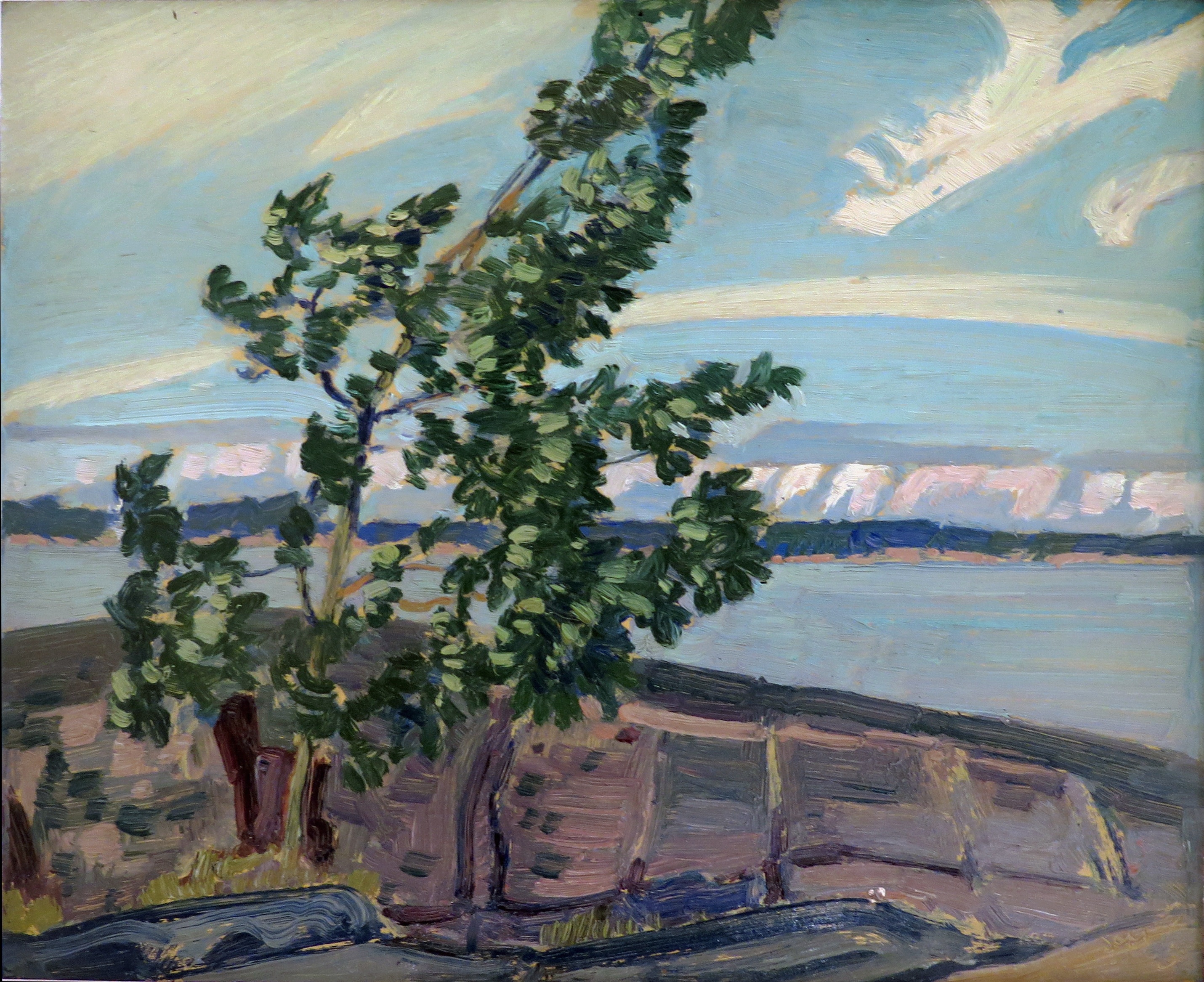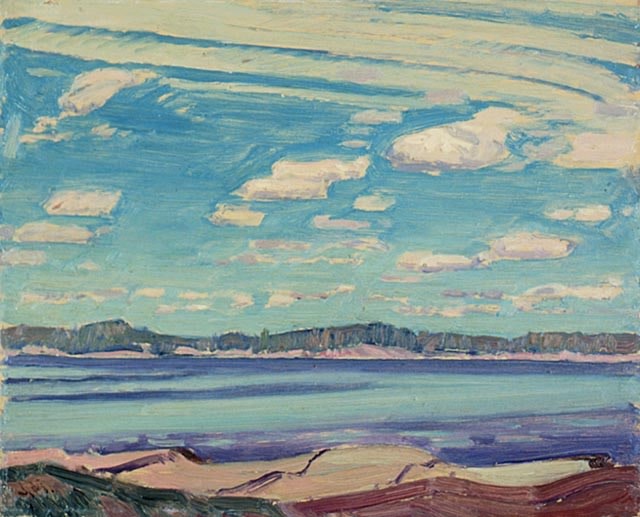J.E.H. MacDonald’s “Last Trip to “‘North Country’”
During a sketching tour to northern Georgian Bay in September 1931, MacDonald painted Poplar Point, Sturgeon Bay. Using an open and fluid brush, his late summer painting depicts a rugged shoreline punctuated by a cluster of poplar trees. With an isolated foreground of trees on a rocky outcrop, a middleground comprising an expanse of water, a background with distant shores and powerful sky, Poplar Point, Sturgeon Bay is a classic Group of Seven composition that recalls some of the most recognizable Canadian paintings of the period such as Varley's Stormy Weather, Georgian Bay, Lismer's A September Gale, Georgian Bay or, going back further, Tom Thomson's The Jack Pine, and The West Wind.

Fig. 1
J.E.H. MacDonald, R.C.A., O.S.A. (1873-1932)
Poplar Point, Sturgeon Bay, September 2, 931
Oil on board, 8 1/2 x 10 1/2 in (21.6 x 26.7 cm)
signed with initials, JEM (recto, lower right);
titled, dated and signed in black ink, "Poplar Point, / Sturgon [sic] Bay, / Sept. 2, 1931 / J.E.H. MacDonald" (verso, upper right);
inscribed in red ink in an unknown hand, "E 428 / 8 3/8 x 10 1/2"
Provenance
Dominion Gallery, Montreal, Inventory No. E 428, as "Poplar Point";
With The Hett Gallery Ltd., Edmonton, Inventory No. C183, as "Poplar Point";
Walter Klinkhoff Gallery, Montreal;
Acquired from the above by the present Private Collection, Toronto.

Fig. 2
J.E.H. MacDonald sketching under the shade of a poplar tree during his trip to Sturgeon Bay in 1931.
To express the elemental power of the gusting wind, MacDonald composes the leaves of his central subject with horizontal licks of blue and greens. Much of the foliage is composed with a laurel green so as to suggest the underside of windswept leaves, which are being illuminated by the sun. MacDonald's thick, excited marks reinforce the physical presence of the poplar and the heavy daubs of oil paint create an almost shimmering surface, reiterating its sunlit glow. The profile of the poplar tree unapologetically obstructs the horizon line and juts into a sky that is alight with a spectacular of sunbathed, tumbling clouds. The complex of mauves, blues, greens, and browns that compose the weathered rock face seem to erupt on the panel surface. One can readily imagine looking out toward a far off horizon, depicted by MacDonald in a subtle arrangement of blue and white, with the flicks of a most adept brush.
This particular view obviously intrigued MacDonald — a very similar composition is housed in The Thomson Collection at the Art Gallery of Ontario [Fig. 3]. A comparative work can also be found at the National Gallery of Canada [Fig. 4].

Fig. 3
J.E.H. MacDonald, Poplars and Rock, Sturgeon Bay Near Pointe au Baril, 1931,
The Thomson Collection at the Art Gallery of Ontario, AGOID.10392

Fig. 4
J.E.H. MacDonald, Sturgeon Bay, near Pointe-au-Baril, 1931,
National Gallery of Canada, Ottawa, Ontario, Accession No. 15497
Of similar scenes, fellow artist and friend of MacDonald, C.W. Jefferys, wrote:
“‘Mr MacDonald’s art is native — native as the rocks, snow or poplar trees that are so largely his theme. In these sketches there is a refreshing absence of Europe, or anything, save Canada, and J.E.H. MacDonald and what they have to say: and so deep and compelling has been the native inspiration that it has to a very great extent found through him a method of expression in paint as native and original as itself’”[1].
Only a month after painting Poplar Point, Sturgeon Bay, MacDonald suffered his first stroke [2]. He and wife Joan subsequently travelled to Barbados in January 1932, returning to Canada the following April [3].MacDonald then suffered a second stroke and died in the fall of 1932, making this trip to Sturgeon Bay the final what Robert Stacey referred to as the artist’s “Last trip to ‘north country [4].’”
ENDNOTES
1. Albert H. Robson, J.E.H. MacDonald: Canadian Artist Series, (Toronto: The Ryerson Press, 1937), p. 5
2. Nancy Robertson, J.E.H. MacDonald, R.C.A., 1873-1932, (Toronto: Art Gallery of Ontario, 1965), p. 14
3. Bruce Whiteman, J.E.H. MacDonald, (Kingston, Ont.: Quarry Press, 1995), p. 78
4. Hunter Bishop and Robert Stacey, J.E.H. MacDonald, Designer: An Anthology of Graphic Design, Illustration and Lettering, (Ottawa:Carleton University Press, 1996), p. 125
EXTERNAL IMAGES CITED
Fig. 2
J.E.H. MacDonald sketching under the shade of a poplar tree during his trip to Sturgeon Bay in 1931. Uncited photograph from Bruce Whiteman, J.E.H. MacDonald, (Kingston, Ont.: Quarry Press, 1995), p. 89, as “J.E.H. MacDonald Sketching, / Sturgeon Bay”; Image is also reproduced in Paul Duval, The Tangled Garden: The Art of J.E.H. MacDonald, (Scarborough, Ont.: Cerberus / Prentice-Hall Ltd., 1978), p. 185, as “J.E.H. MacDonald Sketching, 1931.”
Fig. 3
J.E.H. MacDonald, Poplars and Rock, Sturgeon Bay Near Pointe au Baril, 1931, oil on paperboard, 21.5 x 26.6 cm (8 7/16 x 10 1/2 in.) The Thomson Collection at the Art Gallery of Ontario, AGOID.103920, © 2017 Art Gallery of Ontario.
Fig. 4
J.E.H. MacDonald, Sturgeon Bay, near Pointe-au-Baril, 1931, oil on cardboard, 21.5 x 26.7 cm, National Gallery of Canada, Ottawa, Ontario, Vincent Massey Bequest, 1968, Accession No. 15497







